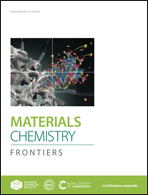Tunable-emission microwire heterojunctions for optical waveguides†
Abstract
Multi-component hybrid optical heterojunctions assembled from chromophore-doped polymer microwires are one of the first choices of building blocks for the construction of complex/integrated functional photonic devices, because they not only have the advantages of the individual components (optical confinement from one-dimensional microstructures, high emission efficiency from chromophore and flexibility from polymer matrix), but also bring novel performances to the system by the synergetic interactions between multiple components which cannot be obtained from single components. Herein, we propose a strategy to construct different waveguide heterojunctions through arrangement and combination of two kinds of polymer doped optical microwires via micromanipulation. One of them (MW1) contains carboxyl-fluorescein and photochromic spiropyran which will undergo photoisomerization upon external light stimuli, producing tunable fluorescence (FL) emission for MW1 due to the adjustable fluorescence resonance energy transfer. The other (MW2) is embedded with the dye rhodamine 6G whose FL always remains almost unchanged. Waveguide logic gate, switch and modulator within these heterojunctions can be well realized by changing the external light stimuli and excitation position. Our study indicates that these tunable-emission microwire heterojunctions composed of responsive dye molecules would provide a novel tactic in developing multi-functional advanced waveguides for integrated micro/nanophotonic devices and circuits.



 Please wait while we load your content...
Please wait while we load your content...